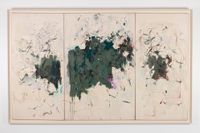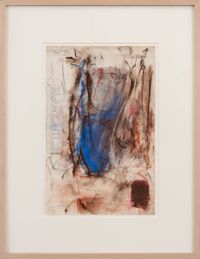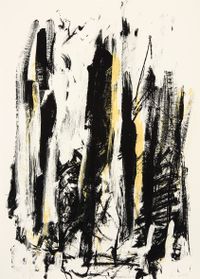Abstract Expressionist painter and printmaker Joan Mitchell was one of the principle figures of the second generation of Abstract Expressionists that emerged from New York in the 1950s. Her signature synesthetic gestural abstractions evoke emotional responses.
Read MoreBorn in Chicago, Mitchell moved to New York in 1949 after spending a year in France on the James Nelson Raymond Foreign Traveling Fellowship from the School of the Art Institute of Chicago, where she had graduated with a BFA in 1947. Mitchell would graduate with an MFA from the same School in 1950.
Inspired by her time in France to move toward abstraction in her work, Mitchell quickly became an active participant in the avantgarde art scene of downtown New York. Her artwork was admired by the likes of Franz Kline, Willem de Kooning, and Hans Hofmann. In 1951 she became one of the few women to be included in The Club, an exclusive gathering place on East Eighth Street for the artists who would become the basis of the New York School of Abstract Expressionism. She was included in The Ninth Street Show (1951, New York), which was curated by Leo Castelli and also featured Robert Motherwell, de Kooning, Jackson Pollock, Hofmann, and Helen Frankenthaler.
Distinct from her predominantly male counterparts, Joan Mitchell developed her own signature rhythmic gestural painting style and synesthetic use of colour to evoke emotion and memory.
In developing her technique, Mitchell was not specifically interested in the style of abstraction but rather in making a 'surface work', prioritising the texture of the canvas and the emotional evocation of abstract forms.
Her technique combined contrasting methods of dripped liquid and densely applied paint, and both areas of flatness and relief. Initially, her focus was on developing her own style of gesture and line, creating a rhythm of contrasting and conflicting lines with a balance of order and disorder, as visible in artworks such as Untitled (1955). She soon began to introduce more in-depth layered fields of luminous colour that she would build up through dense lines in works such as Ladybug (1957) and Goulphar II (1959).
Though appearing unrestrained everything is carefully arranged, with the artist attentive to the layering of paint and the relationship between colours and textures. As the artist explained 'the freedom in my work is quite controlled. I don't close my eyes and hope for the best.' The artist's impact was in how her canvases created moods, typically in response to nature and more specifically the impression it leaves.
Already splitting her time between Paris and New York since 1955, Mitchell fully moved to Paris in 1959. The period between 1960 and 1964 saw a change in her style, marked by her father's death and her mother's cancer diagnosis. The brush strokes became more violent and the colours more sombre. In large multi-panel works such as Girolata Triptych (1963), her form became more singular and dense–an implosion of thick green brush strokes occurs at the centre of each panel, drawing attention from the almost bare canvas that surrounds it.
In 1968, the artist settled in the heartland of French modernism (near Claude Monet's former estate): Vétheuil, a small village northwest of Paris. By this time brighter colours and more diverse and lighter compositions could be found in her canvas. In works such as the 'Sunflower' series semi-figurative evocations of nature and time are apparent.
In Vétheuil, while continuing to paint and maintaining an international presence, she started to regularly host artists at various stages of their careers, providing space and support toward the development of their art. She would also make a series of Pastel drawings in this time.
Alongside paintings and pastels Joan Mitchell was also a printmaker. Her earliest editions accompanied the book The Poems (1960) written by American poet and friend John Ashbery. In 1981, two years after the end of her long term relationship with Canadian painter and sculptor Jean-Paul Riopelle, Joan Mitchell create the Bedford Series, ten large colour lithographs published in New York by Tyler Graphics Ltd.
In 1992, the year Mitchell passed away due to lung cancer, she made one last series of eight colour lithographs for the book Poems, with accompanying text by author Nathan Kernan.
Galleries and auction house have offered Joan Mitchell's artworks for sale at prices in the seven or eight figure range.
At Art Basel Hong Kong in 2021 Lévy Gorvy sold Joan Mitchell's painting 12 Hawks at 3 O'Clock (circa 1962) for around US $20 million, far exceeding previous records.
The Joan Mitchell Foundation website can be found here and the Joan Mitchell Foundation Instagram can be found here.
Michael Irwin | Ocula | 2022






